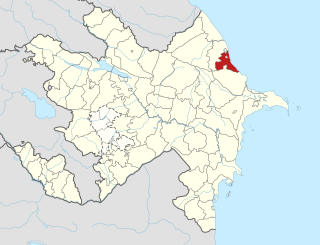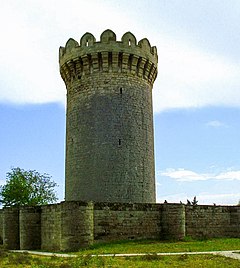
Baku is the capital and largest city of Azerbaijan, as well as the largest city on the Caspian Sea and of the Caucasus region. Baku is located 28 metres (92 ft) below sea level, which makes it the lowest lying national capital in the world and also the largest city in the world located below sea level. Baku lies on the southern shore of the Absheron Peninsula, alongside the Bay of Baku. At the beginning of 2009, Baku's urban population was estimated at just over two million people. Officially, about 25% of all inhabitants of the country live in Baku's metropolitan area. Baku is the sole metropolis in Azerbaijan.

Derbent, formerly romanized as Derbend, is a city in Dagestan of Russia, located on the Caspian Sea. It is the southernmost city in Russia, and it is the second-most important city of Dagestan. Derbent occupies the narrow gateway between the Caspian Sea and the Caucasus Mountains connecting the Eurasian Steppe to the north and the Iranian Plateau to the south; covering an area of 69.63 square kilometres (26.88 sq mi), with a population of roughly 120 thousand residents.

Siyazan District is one of the 66 districts of Azerbaijan. It is located in the north-east of the country and belongs to the Quba-Khachmaz Economic Region. The district borders the districts of Shabran, Khizi, and the exclaves of Quba. Its capital and largest city is Siyazan. As of 2020, the district had a population of 42,600.

The Maiden Tower is a 12th-century monument in the Old City, Baku, Azerbaijan. Along with the Shirvanshahs' Palace, dated to the 15th century, it forms a group of historic monuments listed in 2001 under the UNESCO World Heritage List of Historical Monuments as cultural property, Category III. It is one of Azerbaijan's most distinctive national emblems, and is thus featured on Azerbaijani currency notes and official letterheads.

The Palace of the Shirvanshahs is a 15th-century palace built by the Shirvanshahs and described by UNESCO as "one of the pearls of Azerbaijan's architecture". It is located in the Inner City of Baku, Azerbaijan and, together with the Maiden Tower, forms an ensemble of historic monuments inscribed under the UNESCO World Heritage List of Historical Monuments. The complex contains the main building of the palace, Divanhane, the burial-vaults, the shah's mosque with a minaret, Seyid Yahya Bakuvi's mausoleum, south of the palace, a portal in the east, Murad's gate, a reservoir and the remnants of a bath house. Earlier, there was an ancient mosque, next to the mausoleum. There are still ruins of the bath to the west of the tomb.

The Baku Ateshgah, often called the "Fire Temple of Baku" is a castle-like religious temple in Surakhani town, a suburb in Baku, Azerbaijan.
Baku is the capital of Azerbaijan Republic, which was also the capital of Shirvan, Baku Khanate, Azerbaijan Democratic Republic and Azerbaijan SSR and the administrative center of Russian Baku governorate. Baku is derived from the old Persian Bagavan, which translates to "City of God". A folk etymology explains the name Baku as derived from the Persian Bādkube, meaning "city where the wind blows", due to frequent winds blowing in Baku. However, the word Bādkube was invented only in the 16th or 17th century, whereas Baku was founded at least before the 5th century AD.

Old City or Inner City is the historical core of Baku, the capital of Azerbaijan. The Old City is the most ancient part of Baku, which is surrounded by walls which were easily defended. In 2007, the Old City had a population of about 3000 people. In December 2000, the Old City of Baku, including the Palace of the Shirvanshahs and Maiden Tower, became the first location in Azerbaijan to be classified as a World Heritage Site by UNESCO.
The architecture of Azerbaijan refers to the architecture development in Azerbaijan.

Bay of Baku is a natural harbor of the Baku port and local yacht club, on the southern shore of the Absheron Peninsula and on the western shore of the Caspian Sea.

Sabail raion is a raion of Baku, located on the Caspian shore. It contains the Old town of Baku and the Baku Boulevard as well as the settlements Badamdar and Bibiheybət

Shirvanshah, also spelled as Shīrwān Shāh or Sharwān Shāh, was the title of the rulers of Shirvan from the mid-9th century to the early 16th century. The title remained in a single family, the Yazidids, an originally Arab but speedily Persianized dynasty, although the later Shirvanshahs are also known as the Kasranids or Kaqanids. The Shirvanshah established a native state in Shirvan.

Tourism in Azerbaijan has been an important sector of the Azerbaijani economy since the 1990s. According to Azerbaijan's Center for Economic and Social Development, the country is in 39th place among 148 countries in tourism competitiveness indicators. The World Travel and Tourism Council reported that Azerbaijan is among the top ten countries with the greatest increase in visitor exports from 2010 to 2016. The country had the world's fastest-developing travel and tourism economy in 2017. To promote tourism, Azerbaijan sponsored Atlético Madrid jerseys reading "Azerbaijan – Land of Fire". In 2018, a new tourism brand and a slogan "take another look" were introduced.
Azerbaijani art has developed since ancient times in Azerbaijan and Iranian Azerbaijan. The Azerbaijanis have created rich and distinctive art, a major part of which is applied art items. This form of art rooted in antiquity, is represented by a wide range of handicrafts, such as chasing (metalworking), jewellery-making, engraving, carving wood, stone and bone, carpet-making, lacing, pattern weaving and printing, and knitting and embroidery. Each of these decorative arts is evidence of the culture and the abilities of the Azerbaijan nation, and are very popular there. Many interesting facts pertaining to the development of arts and crafts in Azerbaijan were reported by merchants, travellers and diplomats who visited these places at different times.

Round Tower is a castle located in Mardakan, Baku, Azerbaijan. The castle is also called Shikh fortress by local residents.

Nardaran Fortress was built in 1301 by architect Mahmud ibn Sa'ad in the northern part of Absheron Peninsula.Nardaran Fortress is located 25 km north of Baku in the village of Nardaran near the town of Mashtaga. Shirvanshahs used the fortress for both observation and defense. Nardaran Mosque or Rahimakhanim sanctuary which was built in 1663 is located about 200 m from the fortress.

The Mausoleum of Seyid Yahya Bakuvi was built in approximately 1457-1458, in Baku, Azerbaijan. The mausoleum is located in the centre of the middle yard of the Palace of the Shirvanshahs. Among local people it is known as the mausoleum of “dervish” and was named after the philosopher and thinker Seyid Yahya Bakuvi who is buried in it.

Baku Fortress is the largest of Absheron fortresses. The fortress consists of the Icheri Sheher and the walls and towers surrounding it and it was included by UNESCO into the World Cultural Heritage List in 2000. It was built in about 1138–1139 on the order of the Shirvanshah Manuchohr III (1120–1149).

Shirvanshah's palace mausoleum or tomb of Shirvanshahs’ family is a historical monument of the XV century. Locating in Old City, it is a part of Palace of the Shirvanshahs complex. The mausoleum is one of the three buildings located in courtyard of the complex, the others being Shirvanshah's palace mosque and Shirvanshah's palace bath house.

Old City Museum Center or Icherisheher Museum Center is a museum in Azerbaijan. The Museum Center is a part of the State Department of the Historical and Architectural Reserve of Old City. The museum explores the architecture, life and culture of the ancient Shirvanshahs' Palace, Maiden Tower, ancient mosques, baths, Baku Khans' Palace, and the Gala village. The Center collects, preserves and propagates material about the cultural monuments of the period, and holds international conferences, symposiums, themed parties, theatrical museum events at the Monuments Complex.




















